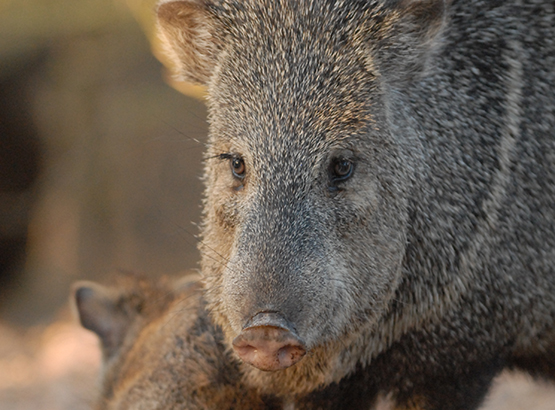Javelina
The collared peccary, or javelina, evolved in South America and migrated north, only recently arriving in Arizona. Javelina bones are not found in Arizona archaeological sites and early settlers made infrequent references to their occurrence. It’s possible that the peccary spread simultaneously with the replacement of Arizona’s native grasslands by scrub and cactus.

About
Adult javelina generally weigh 35 to 60 lbs, the male being slightly heavier than the female. New born javelina weigh about one pound. They are tan to brownish in color with a reddish dorsal stripe. They acquire adult coloration at three months. The salt and pepper appearance of adults is due to whitish bands on the black hairs. These hairs are up to six inches long, with the mane being blackest, longest, and erectile. In the winter, the coat is very dense and dark and the “collar” is visible. In summer, the javelina sheds hair. The shorter hairs are lighter and the collar frequently is not visible.
Hunt History
Javelina were not legally designated as big game until 1929, when a season from November 1 through January 31 was authorized and a bag limit of one javelina a year was imposed. Hunter interest gradually increased, particularly among non-residents, and the javelina became an important game animal in Arizona after World War II. By 1950, hunters were purchasing nearly 10,000 javelina tags and taking more than 1,000 animals a year. In 1959, an archery javelina season was initiated, and by 1971 more than 30,000 hunters were harvesting more than 6,000 javelina a year.
Permit-only HAM (handgun, archery, and muzzleloader) hunts were initiated in 1974, and archery hunting was limited to permit-only hunting in 1992.

Our Mission
To conserve Arizona’s diverse wildlife resources and manage for safe, compatible outdoor recreation opportunities for current and future generations.
Hunt Regulations
Rules and regulations for hunting in Arizona.
Regulations for spring hunts, fall hunts and pronghorn, elk hunts.
